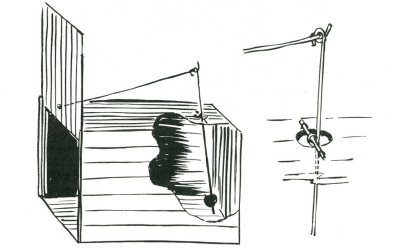
A box is made exactly similar to the box trap on the following page. A hole is bored in the roof 3 inches from the closed-in end. The bait wire is made with an eye at the top, and about four inches below this another eye, and the hooked portion for the bait some eight or ten inches below this lower eye. With this release the cross wire is placed through the lower eye, with the top eye above the roof of the box. The bait is fastened to the hook inside the box, and the release wire secured with its own eye to the top eye, and its farther end lying longways along the roof with the end itself in a small hole through the bottom of the drop door, and in such a position that it holds the door up. When the animal takes the bait, and drags backward with it, the top end of the bait wire is forced to the rear, and so withdraws the wire at the door from the hole and allows the door to stop, imprisoning the animal.
PORTABLE BOX TRAP
BOX TRAPS TO CATCH ANIMALS ALIVE INTERNAL RELEASE
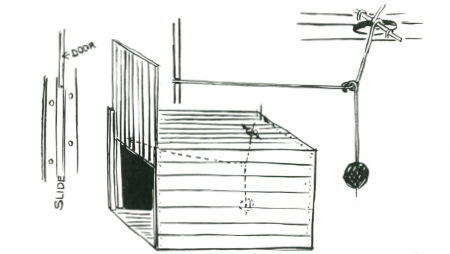
A stout box of a size suitable for the animal to be trapped is made. To one end a sliding door is fitted. This door must slide up and down easily between two grooves. On the inside of the door, and near the lower end a small hole is bored for about a quarter of an inch in depth.
On the roof of the box, about three inches from the closed-in end a hole about one inch diameter is bored right through the wood. The release mechanism is made by taking a piece of stiff wire (8 gauge), bending an eye in it at the head, and another eye about six inches lower down, and immediately below this lower eye bending the wire in a wide hook, and cutting it off at the end of the hook. Through the top eye another short piece of wire is passed (with the eye in the centre of the hole in the roof) and the short piece of wire lying parallel to the end of the box, it is secured in position with a staple at either end. Another piece of wire is fastened to the lower eye, now inside the box. This piece of wire must be just so long that when the hook is slightly forward, the piece of wire will engage in the hole which was bored in a short distance in the foot of the door.
The trap is baited by securing the bait to the U-shaped hook on the lower end of the wire inside the trap. The free end of the inner piece of wire is placed inside the hole at the lower end of the door. When the animal disturbs the bait the wire holding up the door is withdrawn, and the door drops, imprisoning the animal.
PORTABLE BOX WITH INSIDE STICK RELEASE
BOX TRAP TO CATCH ANIMALS ALIVE
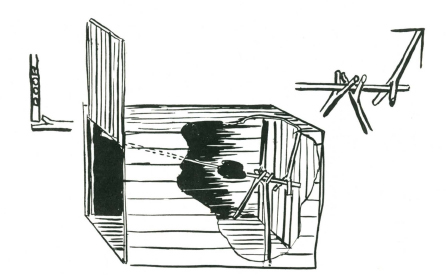
There are occasions when a piece of wire may be unobtainable, then this internal stick release can be improvised. The box is made as for the preceding portable box traps, complete with sliding door. For the release three forked sticks are used with the bait stick, which should have a fork at one end. The length of the three forked sticks should be such that two of them are equal and about three-quarters the height of the inside of the box, and the third should be about half the height. The fork at the end of the bait stick is so trimmed that one end of the fork is about an inch shorter than the other. Setting is effected by placing the bottom of the door on the longer of the two arms of the fork bait stick with the shorter arm in the inside of the door. The two longer forks are set near the end of the box, their forks holding the far end of the bait stick a few inches from its very end. The shorter forked stick is placed with its fork over the farthest end of the bait stick, and its other end against the roof. The bait is secured to the bait stick near the first pair of forks. When the animal takes the bait, it either disturbs the setting of the forked sticks which hold the slide door up, or it pushes the forked end of the bait stick inwards and allows the door to drop.
LOG ROOFED PEN
BOX TYPE BAITED TRAP FOR CATCHING ANIMALS ALIVE
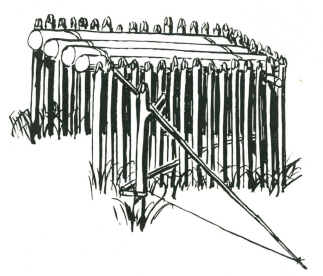
A pen of adequate size for the animal to be trapped is strongly constructed. The pen is built with two sides and one end only. Across the closed end a strong cross bar is secured. Release of the log weighted roof is by means of a toggle and bait stick almost exactly similar to the toggle release of the logfall. A forked stick is stood upright a few-inches from one side of the trap at the open end. Across the fork a supporting stick is placed with the end of the roof logs resting on it. To the far end of this supporting stick a length of cord is fastened, and to the end of this a short toggle stick is tied. The end of the toggle stick is pressed against the bait stick, which in turn is pressed against the stakes opposite and at the far end of the pen. Disturbance of the bait stick releases its engagement with the toggle stick, which in turn releases the support stick and the roof falls heavily, imprisoning the animal in the pen.
BOX TRAP FOR CATCHING ANIMALS ALIVE
FALLING CAGE, FIGURE 4 RELEASE
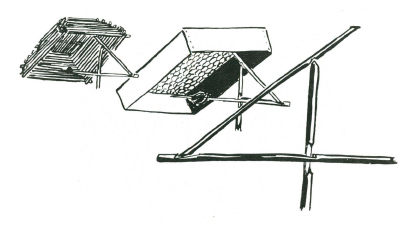
A cage, either of sticks lashed to a pyramidal or other suitable shape, or of boxwood, or netting is made of adequate size. Release is effected by means of the figure 4 release. This is an excellent trap for ground feeding birds, and if the ground is baited with grain, or small fruits it is a certain trap for pigeons. The upright stick is cut with a chisel edge at the top, and a few inches from the bottom end it is squared on all four sides. The support stick is sharpened to a chisel edge at one end, and where it will cross the top of the upright, a nick is cut parallel to the chisel edge. The bait stick has a nick undercut at the thickest end, and at the place where it will cross the upright it has a cut made with a square face at the end of the cut farthest from the undercut nick. Setting is effected by standing the upright in front of the trap, and placing the support stick with its nick on the chisel edge of the upright, and the upper end supporting the raised edge of the box. The chisel end of the support stick is placed in the undercut nick at the end of the bait stick. The squared cut in the bait stick should now engage with a squared face of the support stick, and with the baited end of the stick well under the trap.
WIRE CAGE TRAP FOR RABBITS
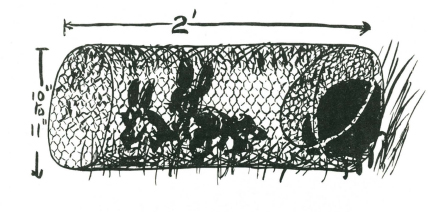
One of the most effective methods of catching rabbits is by means of a wire netting cage trap set at the entrance to one of the burrows of the warren. The warren itself is carefully examined, and a suitable burrow selected for the site of the trap. All the other burrows are covered with a layer of paper stuffed into the hole and packed for a few inches with earth. At the selected burrow the trap, simply made in the form of a long cage of wire netting with one end closed and with the other end as a wire door suspended from the top of the cage and falling so that it can be pushed easily into the trap but when it falls cannot be pushed outwards.
The rabbits in the warren coming to the burrows stuffed with paper are disturbed and suspicious of the rustle of the paper, and come finally to the burrow which has the wire cage in front of it. They push forward into the opening and the door lifting inwards permits them to enter the cage. When they are inside the cage the door drops behind them, and there is no escape back into the safety of the burrow. Ten or twelve rabbits a night can be taken from a warren with this trap, which is far preferable on humanitarian grounds to the steel-jawed commercial trap so commonly used.